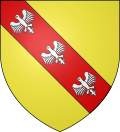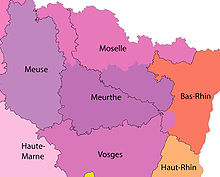Lorraine district
| Lorraine district, department de la Lorraine |
|
|---|---|

|
|
| Seat | Metz |
| Inventory period | 1871-1918 |
| surface | 6,228 km² (1910) |
| Residents | 655,211 (1910) |
| Population density | 105 inhabitants / km² (1910) |
| License Plate | VI C (from 1906) |
| Urban district | 1 (1918) |
| Remaining circles | 8 (from 1901) |

|
|
| Lorraine district (orange) in the Reichsland | |
The district of Lorraine ( French Département de la Lorraine ) was from 1871 to 1918 one of the three districts of the realm of Alsace-Lorraine in the German Empire . The district town was Metz . The area of the district corresponds to that of today's French department of Moselle . In 1910 the district covered 6,228 km² and had 655,211 inhabitants.
history
After the Franco-Prussian War , defeated France ceded Alsace and parts of Lorraine to Germany in the Peace of Frankfurt on May 10, 1871 . Since then they have formed the realm of Alsace-Lorraine. The Reichsland was a member state of the German Reich with a special status, as it initially had no legislation of its own by the Alsatian and Lorraine representatives. From 1874 there was the indirectly elected state committee , which was only upgraded to a directly elected representative body in 1911. As in many federal states of the empire, this was not fully responsible for legislation and did not elect the state government. In the German federal states with limited legislation and government control, power lay with the respective monarchs, in the Reichsland, however, with the imperial governor appointed by the empire . The Reichsland was not represented in the Bundesrat until 1911. Hence the name Reichsland and not federal state. From 1911 it sent three representatives, but because of its special status, the name Reichsland remained.
In addition to the German-speaking part of Lorraine, the Lorraine district also included French-speaking areas west of the German-French language border around Metz and Château-Salins . The districts of the Reichsland were higher municipal associations, therefore not dissimilar to the district association of the Palatinate , whose structures had also emerged from a French department with the Conseil général in 1816 and which was the godfather for the creation of the districts in the rest of Bavaria in 1828. As a higher municipal association , the Lorraine district had a coat of arms, the traditional coat of arms of Lorraine, which appears in seals, on vouchers and bonds of the district.
The territory of the Lorraine district with its capital Metz remained unchanged in terms of its territorial form after the region was returned to France in 1919 and forms what is now the Moselle department. During the German occupation 1940-1944 this area formed the CdZ area Lorraine , part of the Gaus Westmark .
Territorial division
The district of Lorraine was formed from the eastern four-fifths of the former old department of Moselle and the eastern third of the former department of Meurthe (namely its two arrondissements Château-Salins and Sarrebourg ) annexed by Germany . In addition, there were the districts of Upper and Lower Alsace.
The district was divided into circles, mostly taking over the structure of the previously existing French arrondissements . The counties of the district were as follows:
| circle | Emerging from the Arrondissement |
County seat | population | annotation |
|---|---|---|---|---|
| Metz (urban district) | Metz-Ville | Metz | 60,186 (1890) 68,598 (1910) |
22% of the population preferred French as the language (1900) |
| Bolchen | Boulay-Moselle | Bolchen (Boulay) | 41,621 (1890) 41,825 (1910) |
12.8% preferred French (1900) |
| Château-Salins | Château-Salins | Château-Salins | 48,956 (1890) 45,303 (1910) |
69.7% preferred French (1900) |
| Diedenhofen | Briey (partly) and Thionville | Diedenhofen (Thionville) | 84,505 (1890) 115,873 (1900) |
20.8% preferred French, 9.5% Italian (1900) 1901 divided into Diedenhofen East and West |
| Diedenhofen-East | Re-formed in 1901 | Diedenhofen | 62,980 (1910) | |
| Diedenhofen-West | Re-formed in 1901 | Diedenhofen | 88,232 (1910) | |
| Forbach | Forbach | Forbach in Lorraine | 68,696 (1890) 94,191 (1910) |
95% and more preferred German |
| Metz country | Metz Campagne | Metz | 76,805 (1890) 113,674 (1910) |
57.1% preferred French (1900) |
| Saarburg | Sarrebourg | Saarburg in Lorraine (Sarrebourg) | 63,096 (1890) 66,222 (1910) |
22.8% preferred French (1900) |
| Sarreguemines | Sarreguemines | Saargemünd (Sarreguemines) | 66,527 (1890) 74,186 (1910) |
95% and more preferred German |
Territorial changes
On March 1, 1873, the uninhabited parts of the municipality of Raon-lès-Leau , which had previously come to the German Reich through a state treaty with France , and which initially belonged to the district of Saarburg i. Lothr. Were reclassified to the Molsheim district in the Unterelsaß district . On January 1, 1881, the community Großtänchen was reclassified from the Forbach district to the Château-Salins district. On May 14, 1884, parts of the area of the community of Hagen changed from the district of Zabern , Unterelsaß, to the district of Saarburg, while parts of the area of the community of Hültenhausen passed in the opposite direction from the district of Saarburg to the district of Zabern. On June 27, 1890, the Lauterfingen municipality moved from the Château-Salins district to the Saarburg district. In 1891 Lauterfingen came back to the Château-Salins district and the latter gave Mittersheim to the Saarburg district in return . On April 1, 1896, a new municipal code was issued for the Reichsland. On April 8, 1901, part of the municipality of Gandringen came to the district of Metz (Land) and the district of Diedenhofen was divided into an east and a west district. The municipalities of Devant-les-Ponts and Plantières, district of Metz (Land), were incorporated into the city of Metz on April 1, 1908. On April 1, 1914, Le Sablon was incorporated into Metz.
Offices and organs
At the head of each district in the Reichsland was a district president / président du département . His authority was the district presidium / la Présidence du département. As a representative body, each district had a district assembly consisting of elected representatives (cf. district assembly in Bavaria ). In this, the districts in the Reichsland differed from government districts in Prussia, which were not associations of local authorities, but government-side territorial administrative units.
President of the Lorraine District Assembly
The presidents were elected by the District Assembly of Lorraine ( French Conseil Général de la Lorraine ), whose members were in turn elected by the affiliated municipalities.
- 1874–1881: Auguste-François Adam
- 1881–1911: Eduard Jaunez
- 1911–1918: Georges Ditsch
District Presidents
During the war, military governors were installed in the occupied French territories. Adolf von Bonin was governor general of occupied Lorraine until the end of the military administration (general government) on March 28, 1871. Between the end of March and September 1871, a German prefect of Metz held office in place of a French incumbent. In May the area of the later district was annexed. The office of prefect was now named district president, who was appointed by the imperial governor .
- 1871, March – September: Leonce von Könneritz , as prefect
- 1871–1872: Guido Henckel von Donnersmarck
- 1872–1873: Botho zu Eulenburg
- 1873–1874: Adolf von Arnim-Boitzenburg
- 1875–1876: Robert Viktor von Puttkamer
- 1877–1880: Friedrich von Reitzenstein
- 1881–1882: Adalbert von Flottwell
- 1883–1900: Hans von Hammerstein-Loxten
- 1901–1912: Friedrich von Zeppelin-Aschhausen
- 1913–1918: Karl von Gemmingen-Hornberg
bibliography
- Official gazette for the district of Lorraine / Recueil officiel des actes administratifs du Département de la Lorraine (see: Catalog entry of the National and University Library of Strasbourg ; emerged from the official gazette of the Départements Deutsch-Lorraine / Recueil officiel des actes administratifs du Département de la Lorraine allemande ', published from December 18, 1870)
- The old territories of the district of Lorraine including the areas belonging to the Upper Rhine district in the districts of Lower Alsace as of January 1, 1648 , part II, Cologne: DuMont Schauberg, 1909, pp. 176-185.
- Ernst Bruck, The constitutional and administrative law of Alsace-Lorraine : 3 vols., Strasbourg in Alsace: Trübner, 1908-1910. ( Online edition ).
- Stefan Fisch, "Alsace in the German Empire (1870 / 71-1918)", in: The Alsace. Historical landscape through the ages , Michael Erbe (ed.), Stuttgart: Kohlhammer, 2003, pp. 123-146. ISBN 3-17-015771-X .
- Georg Lang, The government district of Lorraine: statistical-topographical manual, administration-schematism and address book , Metz: Lang, 1874
- François Roth , La Lorraine annexée: étude sur la Présidence de Lorraine dans l'Empire allemand (1870-1918) , 2nd edition, Woippy: Serpenoise, 2007. ISBN 978-2-87692-720-9
- Negotiations of the District Assembly of Lorraine / Procès-verbaux des délibérations du Conseil Général de la Lorraine , Metz (published: 1874–1918)
Web links
- "District of Lorraine" on territorial.de
Individual evidence
- ↑ 1910 census
- ↑ German was the official language and its use was encouraged, but bearing in mind the large proportion of French-speaking Lorraine residents, there were bilingual publications, especially in their residential areas in the west and south of the district and in connection with district-wide events and organizations, in which the name Lorraine district with département de la Lorraine is translated. Cf. Official journal for the Lorraine district / Recueil officiel des actes administratifs du Département de la Lorraine .
- ↑ Municipal directory 1910 (accessed on July 6, 2018)
- ↑ a b c d e f g h i “District Lothringen” , on: Rolf Jehke, Territoriale Changes in Germany and German-Administered Areas 1874 - 1945 , accessed on February 25, 2013.
- ↑ The information on the preferred language comes from "Reichsland Elsaß-Lothringen" , in: Michael Rademacher: German administrative history from the unification of the empire in 1871 to the reunification in 1990. dissertation.html. (Online material for the dissertation, Osnabrück 2006).
- ↑ The Italian speakers were mainly migrant workers in the coal and steel industry and their descendants.
- ↑ Formed by imperial decree of April 8, 1901 through the division of the Diedenhofen district.
- ^ Imperial decree of March 1, 1873 [1]
- ^ NN: Bonin, Adolf von . In: Allgemeine Deutsche Biographie (ADB). Volume 3, Duncker & Humblot, Leipzig 1876, p. 128.



